Select Language
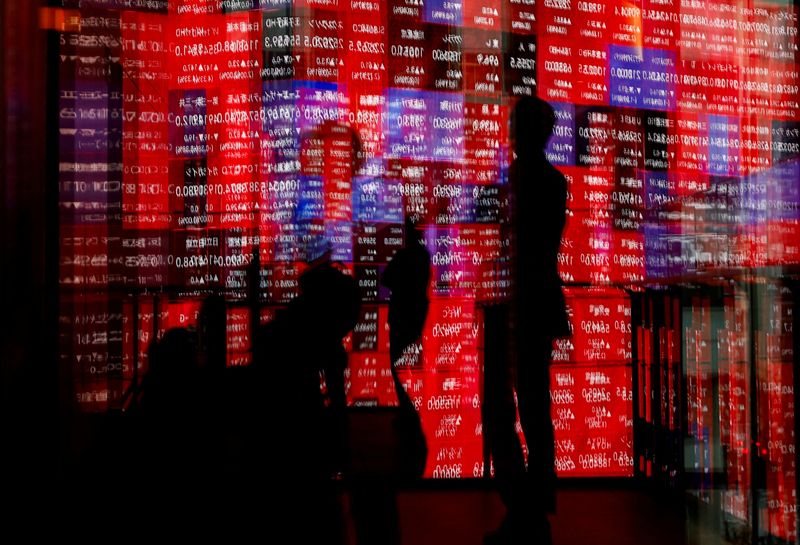
(Reuters) - Asian share markets rebounded on Tuesday reversing a historic sell-off after central bankers sought to calm investor fears.
Japan's Nikkei rallied 9.4% as of the midday break, after plunging 12% on Monday in its biggest one-day percentage drop since October 1987.
Currency markets remained on edge, with the yen down 1% after rising for five straight sessions to a seven-month high on Monday.
QUOTES
RON SHAMGAR, HEAD OF AUSTRALIAN EQUITIES, TAMIM ASSET MANAGEMENT, SYDNEY
"My view is that this market turmoil is mostly driven by the yen carry trade being partly unwound. That’s happened on the same day where U.S. jobs numbers came in slightly weaker than expected and a potential imminent attack by Iran on Israel.
"Combine those factors with a market that so far hasn’t seen the usual and bi-annual pullback or correction of 5-10% this calendar year - and you had a so-called rug pull. We think volatility will persist over the next few weeks and stock prices direction will be dictated by the upcoming results season in Australia and the U.S. during late August."
GARY NG, SENIOR ECONOMIST FOR NATIXIS, HONG KONG
"It is hard to say the worst is behind us ... pressure might linger a little bit."
"There are many moving parts, with three key concerns come from the outlook of the U.S. economy, the unwinding of investors' trades in Japan and geopolitical risks in the Middle East ... particularly the last one, which has not been fully realised for now. As for the U.S. recession outlook, we see some sectors in the economy like consumption still holding up, and datasets in the coming weeks might come out not as bad as the surface looks, and it may help stabilise things."

By Kaori Kaneko and Satoshi Sugiyama
TOKYO (Reuters) -Japan's inflation-adjusted real wages rose in June for the first time in more than two years as nominal pay gained at the fastest pace in nearly three decades, data showed, backing the central bank's view that wage increases are broadening.
However, household spending fell more than expected in the same month, clouding the outlook for the Bank of Japan's plan to steadily raise interest rates.
The latest market rout, which came in the wake of the BOJ's decision last week to raise interest rates, may also dampen consumer sentiment, some analysts say.
Real wages grew 1.1% in June, rising for the first time in 27 months, after a revised 1.3% drop in May, data from the labour ministry showed on Tuesday.
Nominal wages, the average total cash earnings per worker, grew 4.5%, the fastest pace of growth since January 1997, to 498,884 yen ($3,480), the data showed.
Regular pay for permanent workers rose 2.7% in June after a revised 2.6% gain in May, a sign the bumper pay hikes offered by firms in this year's wage negotiations are pushing up household income.
But separate data released on Tuesday showed household spending fell 1.4% in June from a year earlier, more than a median market forecast for a 0.9% drop, suggesting that rising living costs are discouraging consumers from boosting spending.
($1 = 143.3800 yen)
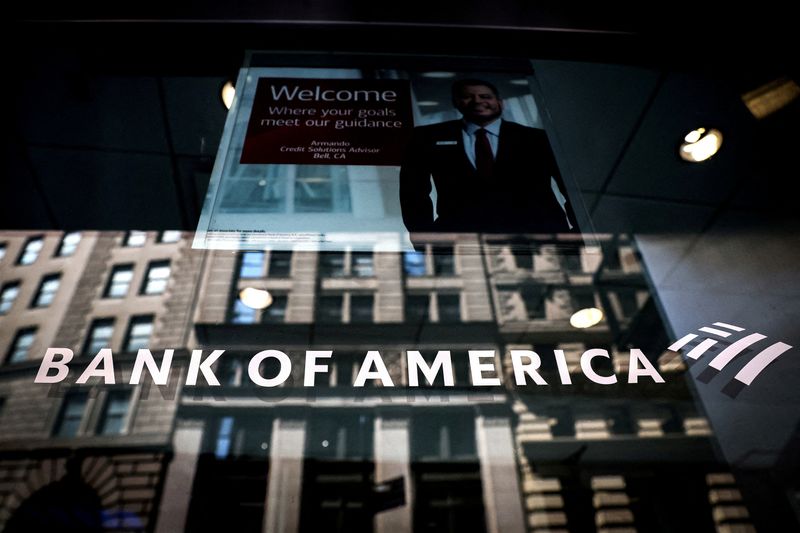
By Manya Saini and Saeed Azhar
(Reuters) -U.S. bank stocks slumped on Monday as fears of a recession sent investors fleeing from a sector closely tied to the health of the economy and toward safe-haven assets.
The S&P 500 Banks Index, tracking a basket of large-cap bank stocks, closed down 2.4%, while the KBW Regional Banking Index fell 2.8%.
Citigroup led big bank losses with a 3.4% fall.
JPMorgan Chase (NYSE:JPM) fell 2% and Bank of America declined nearly 2.5%. Goldman Sachs dropped 2.5%.
Lenders typically feel the squeeze as recessions heighten concerns over credit losses due to higher unemployment. Loan demand - a key factor in profitability - also takes a beating.
"The economy is potentially slowing more than people appreciated, based on last week's economic data, that first and foremost is the biggest driver as it impacts loan growth, income growth, credit quality," said Jason Goldberg, banking analyst at Barclays.
Investors have been jittery since a crisis of confidence hit the sector last year, in part due to higher interest rates, and took down three major regional players.
Among regional banks, Customers Bancorp (NYSE:CUBI)'s shares fell nearly 4.4%, while Huntington Bancshares (NASDAQ:HBAN) dropped 3.4%.
"This market volatility, coupled with potential liquidity dislocation, could pose significant challenges for banks, especially in managing funding and liquidity risks," said Moody's (NYSE:MCO) Corp's banking analyst Laurent Birade.
The U.S. unemployment rate jumped to a near three-year high of 4.3% in July amid a significant slowdown in hiring, heightening fears the labor market was deteriorating and potentially making the economy vulnerable to a recession.
"It's very normal, especially with interest rates having gone up as much as they have and you're seeing that weakness in the commercial real estate market, to see credit losses normalizing," said Erika Najarian, analyst at UBS.
"The jobs print is essentially saying things are not as awesome as they were, they're not saying that things are terrible."
The economic weakness will likely seep into the sector's outlook after a mixed sector-quarter earnings season, where executives from top U.S. banks remained divided over the Fed's future path on interest rate cuts and flagged deterioration in consumer health.
"This may be a few-day blip. I don't think anybody's ready to call this the beginning of a several-quarter downturn in the markets or the economy," said Stephen Biggar, banking analyst at Argus Research.
Morgan Stanley analyst Manan Gosalia said in a note potential rate cuts will be credit positive for mid-sized banks as it will help reduce funding costs and stimulate loan demand.
The S&P 500 Banks Index is down 9.5% month-to-date, compared with a 6% decline in the benchmark S&P 500. The KBW Regional Banking Index has lost about 10% over the same period.
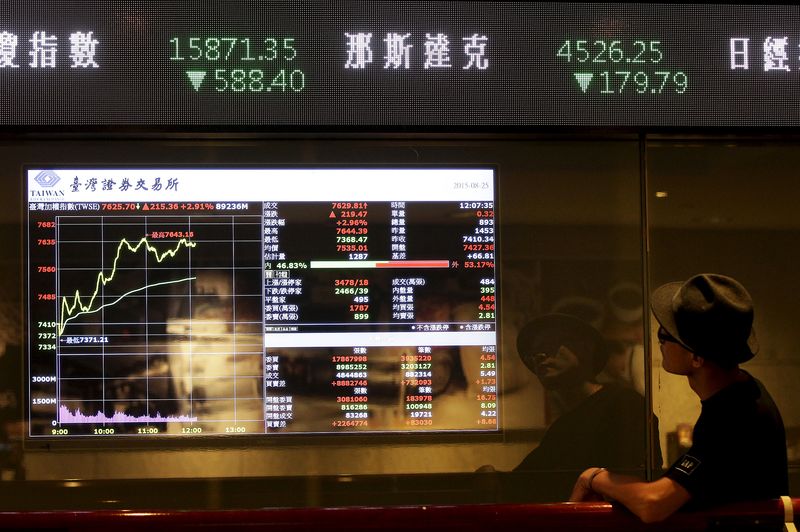
By Faith Hung and James Pomfret
TAIPEI (Reuters) - Taiwan stocks ended down 8.4% on Monday, a record slump, with tech stocks including TSMC plunging as investors sold off one of Asia's top performing markets this year, spooked by a poor outlook for global tech stocks and the U.S. economy.
The main index shed 1,807.21 points, its worst one-day percentage fall, to close at 19,830.88, the lowest level since April 23. The decline was fuelled by a sell-off in tech, and then spread more broadly as the index dipped below the key 20,000 level.
"It is difficult to predict when the decline will stop. It's too early to tell," said David Wu, an analyst with Cathay Futures Consulting Department in Taipei.
Taiwan was one of several markets that tumbled across Asia on Monday amid fears the United States could be heading for recession and as investors sought refuge from risk assets.
Concerns about a widening conflict in the Middle East also weighed on sentiment.
The Taiwan Stock Exchange will hold a media conference to "explain recent market movements and contingency response plans" at 3 p.m. (0700 GMT), the exchange said in brief statement. No further details were given.
A two-day rout late last week left the S&P 500 nearly 6% from its July peak while the tech-heavy Nasdaq Composite extended losses to notch its first 10% correction from a record high since early 2022.
"We think the decline will continue into the next two days, seeking technical support levels of 19,200-19,300 points," Allen Huang, a vice president of Mega International Investment Services, Huang told Reuters.
Shares in the dominant technology stock Taiwan Semiconductor Manufacturing (TSMC), the world's largest contract chipmaker, took a battering. The stock had surged over the past year amid skyrocketing demand for chips used in artificial intelligence, but its price plunged 9.75%, near the daily limit of 10%, to close at T$815.
"The fundamentals for TSMC have not changed at all. Yes, there was market talk last week that delivery of Nvidia (NASDAQ:NVDA)'s new GB 200 chips would be delayed, and Intel (NASDAQ:INTC)'s earnings results were terrible. But TSMC and the upstream AI supply chain would not be affected by those events," Huang added.
Taiwan's Minister of Economic Affairs JK Guo, said investors needed to brace for more possible pain. "Everyone must be prepared for a global stock market crash, this is part of the business cycle," Guo told reporters.
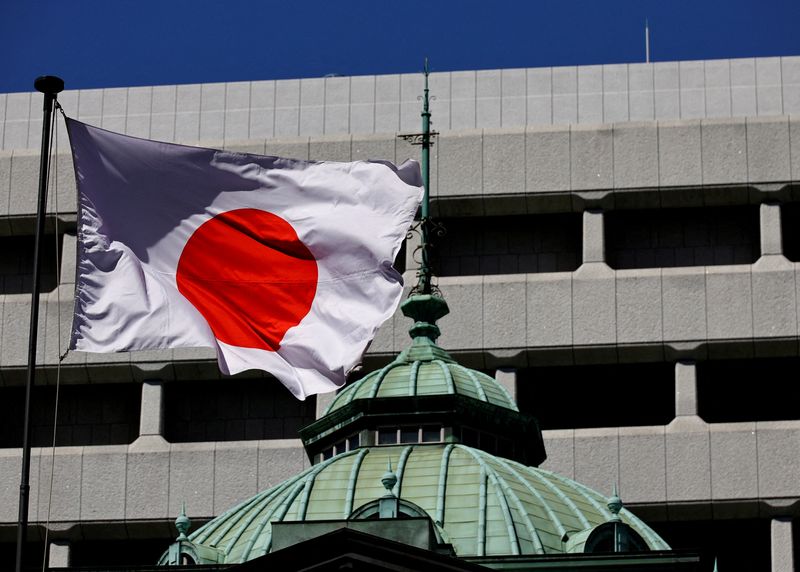
By Leika Kihara
TOKYO (Reuters) -At least two of the Bank of Japan's nine board members called for an early interest rate increase at a policy meeting in June, minutes showed on Monday, underlining the central bank's hawkish tilt that provides scope for further hikes ahead.
"Members agreed that the yen's recent falls were among factors that push up inflation, and must warrant close attention in guiding monetary policy," the minutes showed.
The discussions underscore how yen moves and concerns over an inflation overshoot were key factors discussed at the BOJ's June meeting, and led to its decision in July to raise interest rates to levels unseen in 15 years.
With the Japanese currency having sharply reversed course to hit a 7-month high on Monday, markets are focusing on BOJ Deputy Governor Shinichi Uchida's speech on Wednesday for clues on the pace of future rate hikes.
The yen's latest surge has been buoyed by weak U.S. labour data, which has stoked recession worries.
"Given how latest yen rises are reducing the risk of an inflation overshoot, we expect the BOJ to hike rates at a cycle of once every six months," rather than at a more frequent pace, said Yoshimasa Maruyama, chief market economist at SMBC Nikko Securities.
While the BOJ kept interest rates steady at the June meeting, some board members warned that rising import costs from a weak yen were hurting consumer sentiment and heightening the risk of an inflation overshoot, the minutes showed.
One member said the BOJ must consider "adjusting the degree of monetary easing" to forestall future risks of an inflation overshoot, given how firms are renewing efforts to pass on increasing costs to consumers.
"Another member said the BOJ must continue to closely monitor relevant data in preparation for the next meeting in July and, if deemed appropriate, raise interest rates without delay," according to the minutes.
The yen, which hovered around 157 to the dollar at the time of the June meeting, hit a 38-year low below 161 in July - a move that likely affected the BOJ's decision to hike short-term rates to 0.25% from 0-0.1% at the July 30-31 meeting.
The Japanese currency stood at 145.15 on Monday.
Following the rate hike in July, BOJ Governor Kazuo Ueda did not rule out another increase this year and stressed its readiness to keep hiking borrowing costs to levels deemed neutral to the economy - seen by analysts as anywhere between 1% and 1.5%.
The outlook for private consumption likely holds the key to the next rate hike timing, some analysts say, with rising living costs hurting household sentiment.
"Some members said close attention must be paid to how much boost consumption would get from improvements in income" from wage increases, the June minutes showed.
Japan's second-quarter gross domestic product (GDP) data, due on Aug. 15, will likely show consumption rebounding after four quarters of declines, according to a Reuters poll.
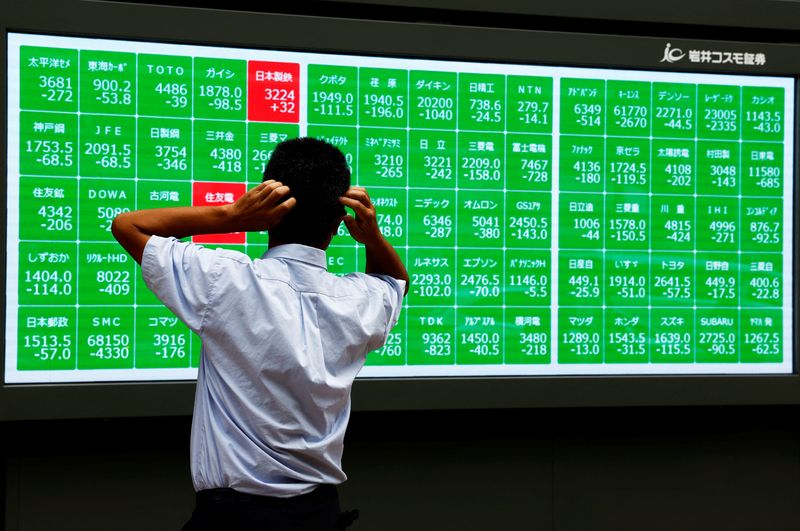
cBy Wayne Cole
SYDNEY (Reuters) -Share markets tumbled and bonds rallied in Asia on Monday as fears the United States could be heading for recession sent investors rushing from risk assets while wagering interest rates will have to fall rapidly to rescue growth.
Investors began where they finished on Friday by knocking Nasdaq futures down 2.27%, while S&P 500 futures dropped 1.41%. EUROSTOXX 50 futures fell 0.6% and FTSE futures 0.2%.
Japan's Nikkei shed a staggering 5.5% to hit seven-month lows, marking its biggest three-session loss since the 2011 financial crisis.
MSCI's broadest index of Asia-Pacific shares outside Japan lost 2.0%. Chinese blue chips were a rare gainer with a rise of 0.4%, aided by a rise in the Caixin services PMI to 52.1.
Japanese 10-year bond yields fell a steep 17 basis points to the lowest since April at 0.785%, as markets radically reconsidered the prospect of another hike from the Bank of Japan.
Treasury bonds were in demand with 10-year yields hitting 3.723%, the lowest since mid-2023.
Two-year yields dropped to 3.818%, having already fallen 50 basis points last week , and could soon slide below 10-year yields, turning the curve positive in a way that has heralded recessions in the past.
The worryingly weak July payrolls report saw markets price in a near 70% chance the Federal Reserve will not only cut rates in September, but ease by a full 50 basis points. Futures imply 115 basis points of cuts in the 5.25-5.5% funds rate this year, and see rates around 3.0% by the end of 2025.

Investing.com -- Fears over the economy are set to remain to the fore amid worries that the Federal Reserve may have left interest rates elevated for too long, allowing them to hurt growth. More high-profile earnings reports are due and oil prices look set to remain volatile amid a combination of recession fears and geopolitical risks. Here's your look at what's happening in markets for the week ahead.
1.U.S. data, Fed speakers
After Friday’s weak July jobs report stoked fears over the prospect of a recession the economic calendar for the week ahead is considerably lighter.
The Institute of Supply Management releases its service sector index on Monday which is expected to point to modest growth.
Investors will get a fresh update on the state of the labor market on Thursday, with the weekly report on initial jobless claims, which are expected to pull back just slightly from an almost one-year high.
Investors will also get a chance to hear from San Francisco Fed President Mary Daly and Richmond Fed President Thomas Barkin after the central bank kept rates on hold last week, but left the door open for a September rate cut.
2. More earnings
While most of the mega cap companies have already reported some high-profile earnings results are expected in the coming days.
Results from industrial bellwether Caterpillar (NYSE:CAT) and media and entertainment giant Walt Disney (NYSE:DIS) will give more insight into the health of manufacturing and the consumer. Also reporting are healthcare heavyweights, including weight-loss drugmaker Eli Lilly (NYSE:LLY) and Super Micro Computer (NASDAQ:SMCI), which is at the center of the market's artificial intelligence excitement.
U.S. stocks sold off for a second day on Friday, pushing the Nasdaq Composite into correction territory as indications that the economy is slowing stoked fears that the Fed has waited too long to cut rates.
Adding to the downward pressure was a drop in Amazon (NASDAQ:AMZN) and Intel (NASDAQ:INTC) after quarterly results and disappointing forecasts.
3. China outlook
Investors will get an update on how the economic recovery in China is shaping up in the second half of the year with a slew of economic releases this week.
The week begins with a private-sector survey on services activity, followed by trade data on Wednesday and a reading on consumer prices at the end of the week.
Recent data has pointed to a gloomy outlook for the world’s number two economy, and recent surprise rate cuts have reflected a growing sense of urgency in Beijing's efforts to shore up growth.
Officials will be keeping an especially close eye on Friday's inflation number for clues on how much more needs to be done to boost lackluster domestic demand.
4. Reserve Bank of Australia decision
The RBA is expected to keep interest rates on hold at its upcoming policy meeting on Tuesday after data last month showed that core inflation unexpectedly slowed to a two-year low in the second quarter and the rate of economic growth moderated in the first quarter.
Market participants will be focusing on the central banks forward guidance with markets pricing in a 70% probability of an easing in interest rates by the end of the year should inflation continue to slow.
5. Oil prices
Oil prices fell on Friday, settling at their lowest since January as weak economic data out of the U.S. and top oil importer China raised worries over the demand outlook.
The soft U.S. jobs report coupled with weakening manufacturing activity in China sent prices lower on the risk that a sluggish global economic recovery would weigh on oil consumption.
Oil investors are also watching the Middle East, where Lebanon's Iran-backed group Hezbollah said its conflict with Israel had entered a new phase.
Meanwhile, an OPEC+ meeting last Thursday left the group's oil output policy unchanged, including a plan to start unwinding one layer of production cuts from October.
--Reuters contributed to this report
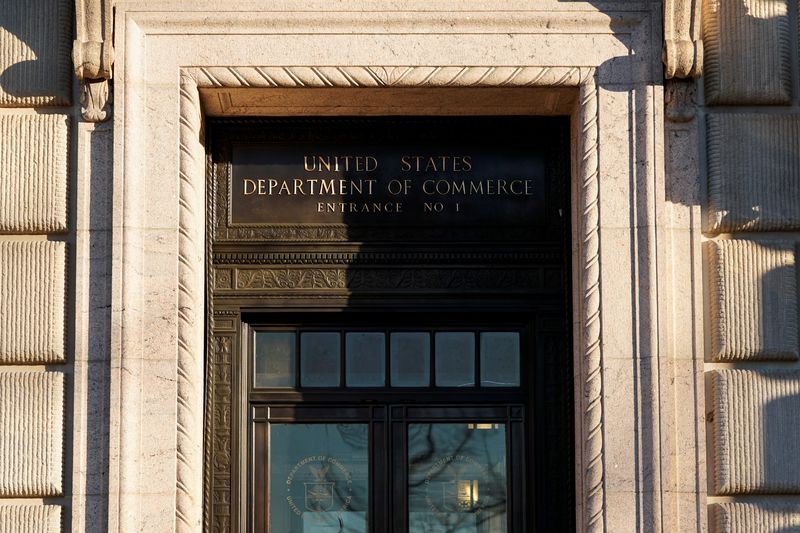
By David Shepardson
WASHINGTON (Reuters) -The U.S. Commerce Department is expected to propose barring Chinese software in autonomous and connected vehicles in the coming weeks, according to sources briefed on the matter.
The Biden administration plans to issue a proposed rule that would bar Chinese software in vehicles in the United States with Level 3 automation and above, which would have the effect of also banning testing on U.S. roads of autonomous vehicles produced by Chinese companies.
The administration, in a previously unreported decision, also plans to propose barring vehicles with Chinese-developed advanced wireless communications abilities modules from U.S. roads, the sources added.
Under the proposal, automakers and suppliers would need to verify that none of their connected vehicle or advanced autonomous vehicle software was developed in a "foreign entity of concern" like China, the sources said.
The Commerce Department said last month it planned to issue proposed rules on connected vehicles in August and expected to impose limits on some software made in China and other countries deemed adversaries.
Asked for comment, a Commerce Department spokesperson said on Sunday that the department "is concerned about the national security risks associated with connected technologies in connected vehicles."
The department's Bureau of Industry and Security will issue a proposed rule that "will focus on specific systems of concern within the vehicle. Industry will also have a chance to review that proposed rule and submit comments."
The Chinese Embassy in Washington did not immediately comment but the Chinese foreign ministry has previously urged the United States "to respect the laws of the market economy and principles of fair competition." It argues Chinese cars are popular globally because they had emerged out of fierce market competition and are technologically innovative.
On Wednesday, the White House and State Department hosted a meeting with allies and industry leaders to "jointly address the national security risks associated with connected vehicles," the department said. Sources said officials disclosed details of the administration's planned rule.
The meeting included officials from the United States, Australia, Canada, the European Union, Germany, India, Japan, the Republic of Korea, Spain, and the United Kingdom who "exchanged views on the data and cybersecurity risks associated with connected vehicles and certain components."
Also known as conditional driving automation, Level 3 involves technology that allows drivers to engage in activities behind the wheel, such as watching movies or using smartphones, but only under some limited conditions.
In November, a group of U.S. lawmakers raised alarm about Chinese companies collecting and handling sensitive data while testing autonomous vehicles in the United States and asked questions of 10 major companies including Baidu (NASDAQ:BIDU), Nio (NYSE:NIO), WeRide, Didi Chuxing, Xpeng (NYSE:XPEV), Inceptio, Pony.ai, AutoX, Deeproute.ai and Qcraft.
The letters said in the 12 months ended November 2022 that Chinese AV companies test drove more than 450,000 miles in California. In July 2023, Transportation Secretary Pete Buttigieg said his department had national security concerns about Chinese autonomous vehicle companies in the United States.
The administration is worried about connected vehicles using the driver monitoring system to listen or record occupants or take control of the vehicle itself.
"The national security risks are quite significant," Commerce Secretary Gina Raimondo said in May. "We decided to take action because this is really serious stuff."
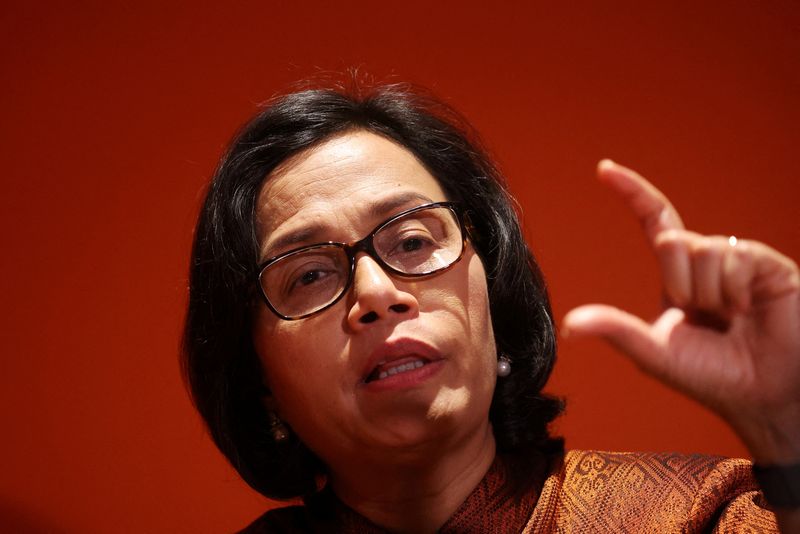
By Gayatri Suroyo and Bernadette Christina
JAKARTA (Reuters) -Indonesia's economic growth probably slowed slightly to 5% in the second quarter and authorities are monitoring geopolitical developments that could affect the domestic economy, its finance minister said on Friday.
Minister Sri Mulyani Indrawati said household consumption, investment and improving exports had likely driven growth in the April-June quarter. The figure would represent only a slight slowdown from the 5.11% annual expansion Southeast Asia's economy recorded in the first quarter.
"Going forward, we see that the increase in domestic economic activity will continue until the end of 2024," she said. "From the fiscal side, the execution of the 2024 budget, particularly on the spending side, will be focused on maintaining price stability."
For all of 2024, Indonesia's economic growth is expected to be within a range of 5% to 5.2%, she said.
The minister's second-quarter estimate is in line with a forecast in a Reuters poll of 24 economists, who pointed to moderating exports and the dampening impact of high interest rates on consumption as factors weighing on growth. The data will be released on Monday.
In a joint press conference with other officials, Sri Mulyani said financial authorities discussed geopolitical developments to anticipate risks that could affect Indonesia's economy, including tensions in the Middle East, the war in Ukraine and elections in other countries.
She said these risks, as well as global uncertainties regarding the timing of U.S. monetary easing, Washington's debt plans and Treasury yield curve, will limit capital inflows to emerging markets, including Indonesia.
Speaking at the same event, Bank Indonesia (BI) Governor Perry Warjiyo said that while low inflation created room for lower interest in recent months, the central bank could not cut rates yet because it was focusing on mitigating the spillover impact of global risks on the rupiah exchange rate.
BI had previously anticipated the U.S. Federal Reserve would cut rates in December, but its meeting this week suggested a probability of a rate cut in September, Warjiyo said.
Warjiyo has previously said BI may have room to cut rates in the fourth quarter, after global uncertainties ease
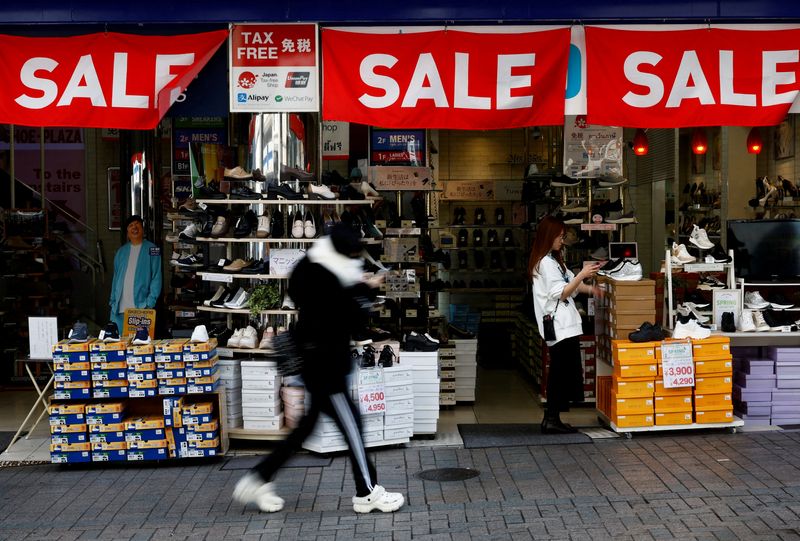
By Leika Kihara
TOKYO (Reuters) - A weak yen is hurting Japanese households' sentiment and could erode their purchasing power, the government said in a report on Friday, underscoring its concern over the negative economic impact of the currency's fall.
When former premier Shinzo Abe's administration deployed its "Abenomics" stimulus policies in 2013, rising inflation expectations helped improve household sentiment, the government said in an annual white paper analysing the economy.
But a renewed rise in inflation expectations since mid-2023 has soured households' mood, partly because the public reacted to media reports about rising food prices and the boost to import costs from a weak yen, it said.
"A weak yen risks eroding consumers' purchasing power" by pushing up inflation more than wage growth, the paper said.
After languishing at 38-lows below 160 per dollar for much of July, the yen staged a sharp rally in the days leading up to and after the Bank of Japan's decision on Wednesday to raise interest rates.
It stood at 149.07 to the dollar in Asia on Friday as investors began shifting their focus on prospects of steady rate hikes by the BOJ, which would come in the face of an expected start to the U.S. monetary easing cycle by the Federal Reserve as soon as September.
In the white paper that was prepared well before Wednesday's BOJ decision, the government said the yen's declines no longer push up export volume as much as in the past as more Japanese manufacturers shift production overseas.
Rather, a weak yen weighs on smaller firms' profits by boosting raw material import costs, the report said.
A weak yen has become a source of concern for Japanese policymakers as it has dampened consumption by inflating the cost of importing fuel, food and raw material.
Japanese authorities spent 5.53 trillion yen ($37 billion) intervening in the foreign exchange market in July to pull the yen off 38-year lows past 160 per dollar, official data showed.
The Bank of Japan also cited the risk of an inflation overshoot from a weak yen as among reasons for raising interest rates on Wednesday.
($1 = 149.5400 yen)

